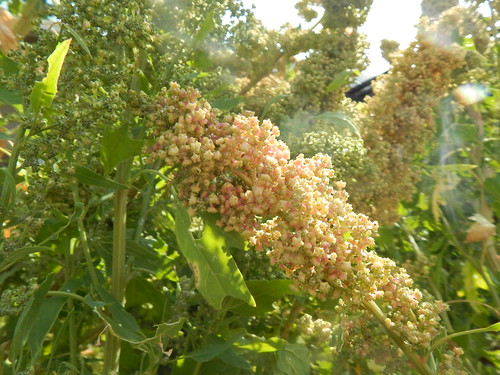Blog Archives
Flooded Gardens
If your garden flooded during the rainfall last week, your produce may not be safe to eat!
After flooding has occurred, the best way to ensure that your produce is safe is to not consume any of it. However, it can be very difficult to throw away a lot of produce that still looks okay.
- If your garden was flooded by rainwater that just didn’t soak in as fast due to the amount of rain, most of the produce is probably safe, if you are sure there were no likely contaminants in the area (fecal matter, industrial chemicals, etc).
- If your garden was flooded by water coming out of ditches, rivers, ponds, or other sources, you should assume that the produce is contaminated. All ripe produce should be harvested and discarded, especially anything normally consumed raw.
- For complete details on safety of produce after flooding, please refer to this fact sheet: Safely Using Produce from Flooded Gardens
Cold, Wet, Wet, Cold… Strawberries!
I don’t know about you, but I feel like I live in Seattle or England, or someplace else that is reputed to be cold and rainy. While I’m not going to complain about the rain (too much), the colder than normal temperatures combined with the rain are causing some garden challenges that we are not used to seeing in Kansas. Namely, a lot of diseases and related problems that we aren’t used to! All those problems that are listed under the “caused by cool, wet conditions” we typically ignore. Well, not this year!
 Luckily for us, the Demo Garden has excellent drainage (we installed drains a few years ago) and raised beds to help keep the soil warmer and drier than would otherwise be the case. Even so, we were still having issues with the beans due to cold soils. I’m curious to see how the squash does, particularly some of the heirlooms.
Luckily for us, the Demo Garden has excellent drainage (we installed drains a few years ago) and raised beds to help keep the soil warmer and drier than would otherwise be the case. Even so, we were still having issues with the beans due to cold soils. I’m curious to see how the squash does, particularly some of the heirlooms.
 Of course, the lettuces and greens are perfectly happy with the weather. I’ve noticed some slugs and roly polys enjoying my lettuce at home, because they love the moisture. If you are seeing slugs or roly polys, the best thing to do is to improve the air circulation around your plants. In my case, I was seeing the problem in lettuce that I hadn’t yet gotten thinned out. The areas where the plants were not too thick were unaffected. Roly polys love decaying organic matter, so removing any damaged, diseased, or dying leaves is also important.
Of course, the lettuces and greens are perfectly happy with the weather. I’ve noticed some slugs and roly polys enjoying my lettuce at home, because they love the moisture. If you are seeing slugs or roly polys, the best thing to do is to improve the air circulation around your plants. In my case, I was seeing the problem in lettuce that I hadn’t yet gotten thinned out. The areas where the plants were not too thick were unaffected. Roly polys love decaying organic matter, so removing any damaged, diseased, or dying leaves is also important.
As I was belatedly thinning out my lettuce, I also noticed some leaves with disease lesions on them. Also due to cold, wet, and poor air movement.
Our Hotline has been taking lots of calls about fungus, including instances of potato plants rotting off. Cold, wet, poor drainage are the culprits. In this case, there’s not much to do now, other than do what you can to improve air circulation and drainage. We haven’t seen a problem in the demo garden since the potatoes are in a tall raised bed.
 The new strawberries are happily filling in rapidly with the mild weather. The older plants are still producing some berries. Fruiting strawberries can be quite negatively affected by cold, wet weather. At home, I’ve observed slugs and roly polys eating fruit, as well as numerous berries with rotting fruit due to the wetness. Again, the keys are keeping the fruit as clean and dry as possible. I don’t have a good straw layer down, which is resulting in berries sitting on dead leaves – not good! The weather has resulted in me doing something that I almost NEVER do – pick fruit before it is 100% ripe. I’m sacrificing the best flavor for not damaged berries, which I’m willing to do under the circumstances. It’s also important to pick and remove any berries showing damage, because the rain will just keep spreading the fungal spores to the remaining fruit and the problem gets worse.
The new strawberries are happily filling in rapidly with the mild weather. The older plants are still producing some berries. Fruiting strawberries can be quite negatively affected by cold, wet weather. At home, I’ve observed slugs and roly polys eating fruit, as well as numerous berries with rotting fruit due to the wetness. Again, the keys are keeping the fruit as clean and dry as possible. I don’t have a good straw layer down, which is resulting in berries sitting on dead leaves – not good! The weather has resulted in me doing something that I almost NEVER do – pick fruit before it is 100% ripe. I’m sacrificing the best flavor for not damaged berries, which I’m willing to do under the circumstances. It’s also important to pick and remove any berries showing damage, because the rain will just keep spreading the fungal spores to the remaining fruit and the problem gets worse.
![20150520_153436[1]](https://thedemogardenblog.files.wordpress.com/2015/05/20150520_1534361.jpg?w=604&h=340) The last problem that we can expect from the rain and cold is root damage. You can see this strawberry plant has some black and brown roots that have been damaged by the excess moisture. While we probably won’t see much sign of root damage until the rain stops, it’s likely to be a problem. I can already tell you that my basil at home isn’t going to make it. Signs of root damage include yellowing leaves, leaf curl/wilting (especially when the soil is still moist), and stunted growth. With as much rain as we’ve had, I also won’t be surprised if we see some nitrogen deficiencies in areas with sandier soils.
The last problem that we can expect from the rain and cold is root damage. You can see this strawberry plant has some black and brown roots that have been damaged by the excess moisture. While we probably won’t see much sign of root damage until the rain stops, it’s likely to be a problem. I can already tell you that my basil at home isn’t going to make it. Signs of root damage include yellowing leaves, leaf curl/wilting (especially when the soil is still moist), and stunted growth. With as much rain as we’ve had, I also won’t be surprised if we see some nitrogen deficiencies in areas with sandier soils.
Well…except that we needed the rain, this post has been as gloomy as the weather! But it’s not all bad:
Friday PhotoEssay – August 8th
It rained again! Quite a bit actually. The rain gauge in the garden only measured about 2″, but I hadn’t realized that the Cuban Oregano had kind of grown over it. So…we’re just guessing. Then again, we’re not that far from the airport that recorded less than an inch. My neighbor recorded 3.5 inches. (My rain gauge at home is laying on its side…not very effective for measuring the rain.)
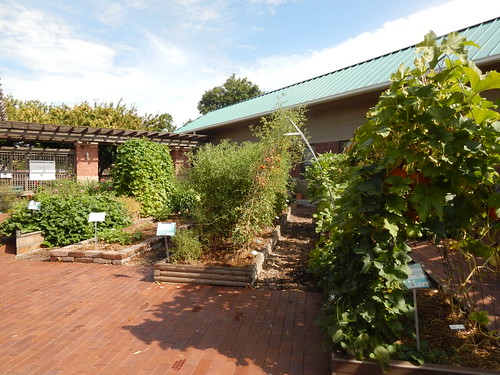 Here’s the whole garden picture from this morning. I feel like we are in a “maximum garden growth” stage with not much visible change at this point. Well…until you get closer, that is.
Here’s the whole garden picture from this morning. I feel like we are in a “maximum garden growth” stage with not much visible change at this point. Well…until you get closer, that is.
 There are a couple small berries on the ‘Ozark Beauty’ plants. They both had a couple of small bug bites, so I picked them off and sampled the other side of the fruit. My opinion? They were soft, which is understandable given the rain, but still too soft. It is usually considered “okay” for a fruit grown in a home garden to be softer, but I think these would have been mush by the time you picked a bowl full and took them inside. Assuming you could get a bowl full. They are small, which is also annoying. What would make up for these factors? Great flavor. Well…in this case the flavor was okay, but mostly just sweet with no depth. Again, partially explained by the rain, but still… This is a variety that you can find at lots of box stores in the spring and is touted as one of the best “everbearing” strawberries for home gardeners.
There are a couple small berries on the ‘Ozark Beauty’ plants. They both had a couple of small bug bites, so I picked them off and sampled the other side of the fruit. My opinion? They were soft, which is understandable given the rain, but still too soft. It is usually considered “okay” for a fruit grown in a home garden to be softer, but I think these would have been mush by the time you picked a bowl full and took them inside. Assuming you could get a bowl full. They are small, which is also annoying. What would make up for these factors? Great flavor. Well…in this case the flavor was okay, but mostly just sweet with no depth. Again, partially explained by the rain, but still… This is a variety that you can find at lots of box stores in the spring and is touted as one of the best “everbearing” strawberries for home gardeners.
Okay, because I can, I’m going to compare these to another variety (not in the Demo Garden) just to show the difference.
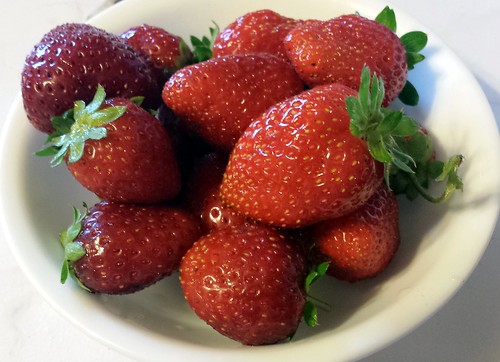 These strawberries are a variety called ‘Albion,’ which is one of the day neutrals we considered planting in this garden. Instead we chose ‘San Andreas’ which was supposed to be better than this variety. Unfortunately, it didn’t make it, we suspect due to residual herbicide issues. I have been getting a solid handful of berries from my plants (and a friend with the same plants has too). The berries are consistently medium to large sized, firm but not too firm, and have GREAT flavor. This is a variety that is a commercial variety for market growers. Maybe I’m missing something, but why wouldn’t this variety be better in your home garden too? Why as a home gardener should you be given the “best” choice of something that is clearly sub-par rather than a great variety like this one?
These strawberries are a variety called ‘Albion,’ which is one of the day neutrals we considered planting in this garden. Instead we chose ‘San Andreas’ which was supposed to be better than this variety. Unfortunately, it didn’t make it, we suspect due to residual herbicide issues. I have been getting a solid handful of berries from my plants (and a friend with the same plants has too). The berries are consistently medium to large sized, firm but not too firm, and have GREAT flavor. This is a variety that is a commercial variety for market growers. Maybe I’m missing something, but why wouldn’t this variety be better in your home garden too? Why as a home gardener should you be given the “best” choice of something that is clearly sub-par rather than a great variety like this one?
Okay, end of mini-rant.
 This is yet another case in point of why it is a good idea to pick your heirloom tomatoes early, when they just start to turn, rather than wait until they are fully ripe. This horrendous crack is due entirely to the rain we got.
This is yet another case in point of why it is a good idea to pick your heirloom tomatoes early, when they just start to turn, rather than wait until they are fully ripe. This horrendous crack is due entirely to the rain we got.
Do you see it? Do you see the tinge of pink showing up on this head of quinoa? Am I way to excited/anxious about this quinoa getting to the colorful stage? Yes, probably just a bit. If you think I may be more excited about the colors than actually harvesting the quinoa, you may be right.
 We have some radish seedlings! These are the Watermelon Radishes which seem to get planted at least every other year in the garden. These are in the MG Faves garden, so we will be looking for some colorful radishes later this fall.
We have some radish seedlings! These are the Watermelon Radishes which seem to get planted at least every other year in the garden. These are in the MG Faves garden, so we will be looking for some colorful radishes later this fall.
Have a great weekend!
Friday PhotoEssay for July 18th
What a chilly week for mid-July! I’m a little bit sad that Tomato Day isn’t this weekend, because the weather would be gorgeous. Instead we are looking at next weekend, and the forecast looks like it will be almost 100 degrees. Ah well, it wouldn’t be Tomato Day if it wasn’t hot!
 Here’s a look at the garden for this week. The vining things continue to be crazy…except for the plants on the trellis over the walkway. Oh well, at least plants aren’t falling on our heads this way.
Here’s a look at the garden for this week. The vining things continue to be crazy…except for the plants on the trellis over the walkway. Oh well, at least plants aren’t falling on our heads this way.
 Can you guess what this is? I know that’s a risky proposition in our garden this year. This is the ‘Sambar’ cucumber, which is the cooking cucumber that will be yellow with brown spots when ripe.
Can you guess what this is? I know that’s a risky proposition in our garden this year. This is the ‘Sambar’ cucumber, which is the cooking cucumber that will be yellow with brown spots when ripe.
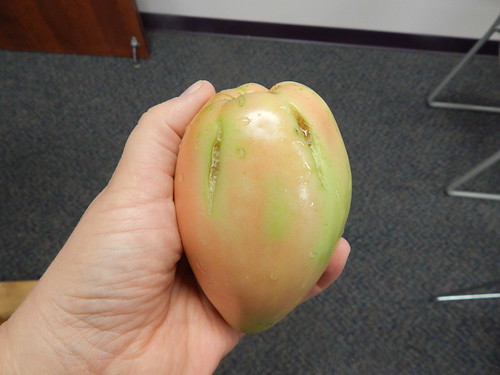 Even though the rain was kind of slow and drizzly and the weather wasn’t too hot, some of the heirlooms are still cracking. This is a ‘Pink Russian 117’ that is just starting to turn but is already showing some cracks. Many heirlooms are prone to cracking due to thin skins. The best way to prevent problematic cracking is to pick the tomatoes as they are just starting to ripen, especially if there has been rain.
Even though the rain was kind of slow and drizzly and the weather wasn’t too hot, some of the heirlooms are still cracking. This is a ‘Pink Russian 117’ that is just starting to turn but is already showing some cracks. Many heirlooms are prone to cracking due to thin skins. The best way to prevent problematic cracking is to pick the tomatoes as they are just starting to ripen, especially if there has been rain.
 This is the Amana Orange. I’m pleasantly surprised by this variety. I thought for sure it would have the lowest yield and be late producing. It seems to have relatively good fruit set for an heirloom with this size fruit.
This is the Amana Orange. I’m pleasantly surprised by this variety. I thought for sure it would have the lowest yield and be late producing. It seems to have relatively good fruit set for an heirloom with this size fruit.
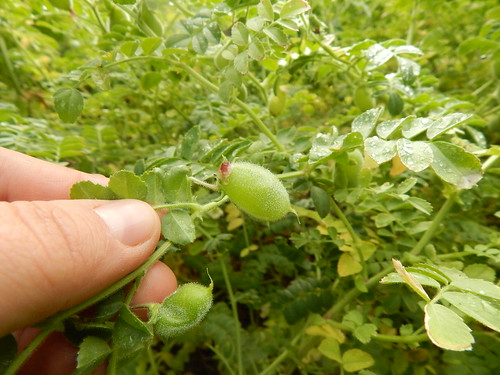 The chickpeas have pods! I haven’t found very many, but they are there. The pods are so small, and I think they will only have one or two peas per pod. I suspect we will have a fairly low yield!
The chickpeas have pods! I haven’t found very many, but they are there. The pods are so small, and I think they will only have one or two peas per pod. I suspect we will have a fairly low yield!
 One of these things is not like the other… Look at that weird cucumber! Oh, wait, it’s not a cucumber. That is a bitter melon or bitter gourd. The variety we are growing is supposed to be harvested at about 8-10″ in length. We picked two on Tuesday and I’m sure there will be more to come. Now to find a recipe…
One of these things is not like the other… Look at that weird cucumber! Oh, wait, it’s not a cucumber. That is a bitter melon or bitter gourd. The variety we are growing is supposed to be harvested at about 8-10″ in length. We picked two on Tuesday and I’m sure there will be more to come. Now to find a recipe…
Have a great weekend!
Friday PhotoEssay
Yikes that rain is cold this morning! It looks like there’s a chance of frost this evening as well, although the forecasts are for about 34 degrees. Looking at the long range forecast, it seems like there’s a chance for below-freezing temperatures around Halloween. BUT, since we are down to cool season vegetables in the Demo Garden, it doesn’t make much difference to us what the weather forecast is at this point!
 Okay, I forgot about the sweet potatoes. Those are coming out this next Tuesday though, so after that we are left with our perennial herbs and cool season vegetables. I braved the cold rain to get a few more pictures this morning as well.
Okay, I forgot about the sweet potatoes. Those are coming out this next Tuesday though, so after that we are left with our perennial herbs and cool season vegetables. I braved the cold rain to get a few more pictures this morning as well.
 Do you see it? This is the ‘Purple Peacock’ sprouting broccoli in the Kids’ Snack Garden. There’s the beginning of one tiny head of purple broccoli. From looking online, it seems like it should get bigger than this before we harvest it.
Do you see it? This is the ‘Purple Peacock’ sprouting broccoli in the Kids’ Snack Garden. There’s the beginning of one tiny head of purple broccoli. From looking online, it seems like it should get bigger than this before we harvest it.
 One of the ‘Rattail’ radishes has bolted and started to flower. Yay! We should have a rattail or two to try later on.
One of the ‘Rattail’ radishes has bolted and started to flower. Yay! We should have a rattail or two to try later on.
 These salad greens have long since overgrown the “salad” stage, but they do still look beautiful and tasty! Mostly they are kales and mustard greens, shading the endives/escarole/chicories in between them.
These salad greens have long since overgrown the “salad” stage, but they do still look beautiful and tasty! Mostly they are kales and mustard greens, shading the endives/escarole/chicories in between them.
 In the spinach section, there is one big plant sporting pointy leaves (not usually a good sign), and a bunch of small plants.
In the spinach section, there is one big plant sporting pointy leaves (not usually a good sign), and a bunch of small plants.
 This heirloom ‘Purple of Sicily’ cauliflower is still just thinking about starting a head, but the veins, leaf petioles (stems), and main stem are such a pretty light lavender color that I wanted to share anyway.
This heirloom ‘Purple of Sicily’ cauliflower is still just thinking about starting a head, but the veins, leaf petioles (stems), and main stem are such a pretty light lavender color that I wanted to share anyway.
 One of our Master Gardeners took a few of the ‘Scarlet Queen’ turnips to try a recipe for Pink Turnip Soup. The turnips had a nice red skin and a little pink in the centers. Unfortunately, she said the the color wasn’t strong enough to make the soup pink and it turned out to be an ugly brown. Oh well…at least the before picture is nice!
One of our Master Gardeners took a few of the ‘Scarlet Queen’ turnips to try a recipe for Pink Turnip Soup. The turnips had a nice red skin and a little pink in the centers. Unfortunately, she said the the color wasn’t strong enough to make the soup pink and it turned out to be an ugly brown. Oh well…at least the before picture is nice!
Have a great weekend!

